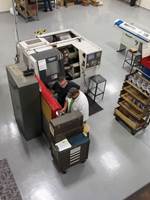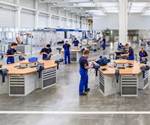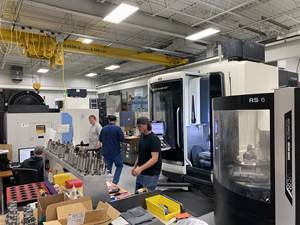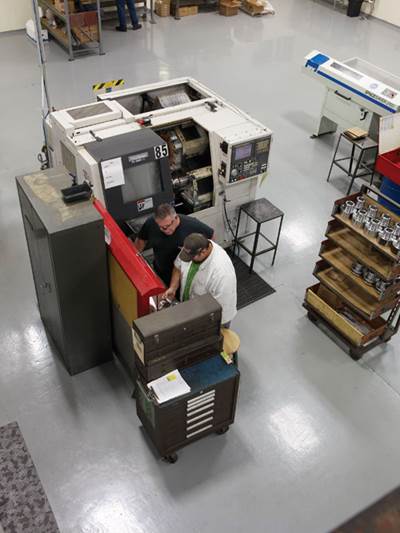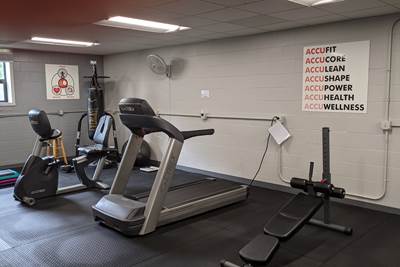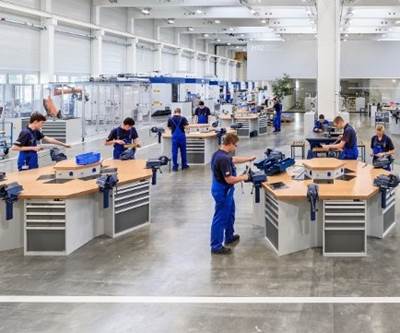Top Shop Builds Upon Employee Ownership for Future Success
In its quest to become the Fox Valley’s best-in-class employer, A to Z Machine has adopted an ESOP, expanded benefits and invested in apprenticeships.

Everyone here is or was a youth apprentice. In addition to two current youth apprentices working at A to Z Machine through the Wisconsin Youth Apprenticeship Program, A to Z Machine employs 13 of its previous youth apprentices.
In 2017, A to Z Machine’s four founders sold the company to their employees.
As dramatic as that sounds, this did not lead to an overnight sea change for the job shop, which gradually acclimated to the realities of employee leadership and ownership. For most A to Z employees, ownership means a supplemental retirement fund, one which grows with the company’s success and which the manufacturer can reinvest in itself to build toward future profits. When viewed in this way, employee ownership is simply one of several human resource-related decisions the company has made to stay competitive now while setting up future success — and which have made it the 2022 Top Shops Honoree for HR.
Machining From A to Z
A to Z Machine started in 1996 with four co-owners — Dale Skovera, Jerry Van Handel, Scott Voet and Dave Reiter — whose business plan was as simple as providing for their families. The Appleton, Wisconsin, shop easily surpassed that goal, moving across town in 2000 to a larger location and expanding several times in the two decades since. Today the company has about 110,000 square feet of manufacturing space and employs over 140 people.
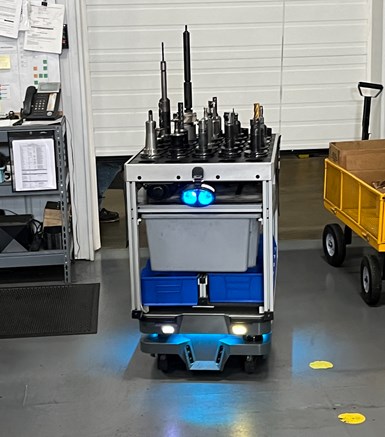
A to Z Machine set up and integrated TED (“Tools Efficiently Delivered”) in-house. The autonomously driving robot now delivers tooling to the shop floor in A to Z’s milling and turning facility.
The job shop creates components for a wide abundance of industries, from marine to defense to food processing and more. Most of these parts are one-offs, but A to Z also does its share of repeat jobs. These repeat jobs benefit from custom fixtures that the company builds through SolidWorks, as well as from a custom system that enables machinists to order tooling for jobs saved in the company’s Epicor ERP. Early-stage automation includes setup-reducing Mazak pallet systems, a machine tending robot and an autonomous tool delivery vehicle nicknamed TED. These processes and types of equipment simplify the work of A to Z’s machinists across two shifts, and the pallets and machine tending robot even enable a small amount of lights-out work.
Leadership by the Employees, For the Employees
When A to Z’s founders began considering retirement, they found themselves with a problem. The founders had multiple family members working in the company, so simply passing it to their families would quickly become a complicated matter. Selling to a private equity firm was an option, but the founders worried about the security of their employees’ jobs under this choice. Ultimately, they decided to sell the company back to the employees as an ESOP (employee stock ownership program).
While the ESOP was founded on October 1, 2017, the founders did not all leave immediately. They gradually retired as A to Z’s employee leadership team, already in existence prior to the ESOP’s founding, took more and more agency in the shop’s day-to-day management. This transition period ended when Scott Voet, the last of the founders to remain with the company, departed in February 2022.

A to Z Machine’s eight-person executive team includes representatives from each of the shop’s major departments. Only four of them report directly to their board of directors and the trustee, but all eight make the important decisions that shape the company’s future. This structure was familiar to the company and its clients, as the four founders also worked as a leadership team.
Determining how the employee ownership concept would manifest across the company was “a learning curve for all of us,” says Amanda Schabo, A to Z’s finance manager. With more than 140 employees, a flat structure would be impossibly unwieldy. Instead, leaders of eight departments come together for large-scale decisions, and consult within their departments for decisions that directly affect them — such as what to buy when considering new machines. The leadership team reports to a three-person board of directors (A to Z co-founder Dave Reiter, plus two unaffiliated members) and a trustee to prove that they are taking the best actions for the company’s future and supporting the ESOP.
Operations manager Don DeWitt says there is little difference between running a company on behalf of an ESOP and running it on behalf of private shareholders. Leadership must act in the best interest of the shareholders — who, in this case, are the employees. Shares release to employees once per year, proportional to their percentage of the total payroll. Yearly valuations mean that the better the company does, the higher the share value goes and the more valuable these shares become for employees. The shares operate as a secondary retirement program, accumulating value tax-free until paid out — much the same as a 401(k).
Danielle Spigarelli, A to Z’s human resources manager, says that referrals have resulted in some of the company’s strongest hires within the last two years. She reasons that “people will only refer the people they’re willing to work next to,” so current hard workers are likely to refer fellow hard workers.
A to Z is currently using its tax-free earnings to reinvest in equipment and using its normal operating cash to pay out former shareholders. As the ESOP matures and more fully vested employees retire or otherwise leave the company, A to Z plans to alter this structure with an account specifically set aside for paying out shares, but for now this current structure enables the company to invest in ways to stay competitive in the pandemic market.

The influx of capital A to Z Machine has enjoyed as a result of adopting a tax-free ESOP has helped the company invest in new machines, such as a large-format Doosan DCM-2740F II double-column bridge mill. This machine was being installed during our visit in mid-July but should be up and running around the time of IMTS.
This competitiveness includes new machining capabilities, such as large-format machining with a Doosan DCM-2740F II double-column bridge mill. This massive machine both opens the door to new parts the company previously could not complete and streamlines the process of creating complex existing parts, with a universal head that enables the shop to combine certain operations.
Hiring Perks and Benefits
A to Z Machine’s leadership team members say their goal is to make the company the supplier and employer of choice in its area. While they believe the company’s wide array of equipment and capabilities can make it the former, achieving the latter has required additional work. The ESOP promises a comfortable retirement but improving the day-to-day work experience has been a high priority for the company.
Part of improving this experience is filling open positions to reduce the number of process bottlenecks at A to Z. While the company has successfully filled most of its first-shift positions, it is actively recruiting for its second shift. Many young employees work second-shift for their first few years with the company, enjoying a three-day weekend and salary differential in exchange for the late-night hours.
Don DeWitt, operations manager of A to Z, says there is very little difference between running a company on behalf of an ESOP and running it on behalf of private shareholders.
A to Z has also found success hiring through its employee referral program. The company recently overhauled this program, increasing the referral bonus for recommending new staff with higher experience and shortening the timeframe required before the referring employees earn this bonus. Danielle Spigarelli, A to Z’s human resources manager, says that referrals have resulted in some of the company’s strongest hires within the last two years. She reasons that “people will only refer the people they’re willing to work next to,” so current hard workers are likely to refer fellow hard workers.
New hires receive a comprehensive orientation, with training on quality sheets, ISO requirements, the tooling request process and safety. New machinists also spend time with the inspection, tooling, gaging and shipping and receiving departments to get a better idea of the shop’s process idiosyncrasies. A to Z has also recently started to conduct check-ins at 30, 60 and 90 days after hiring, getting feedback about onboarding and determining what additional training opportunities are best suited for the new employee. This feedback has already enabled A to Z to start refining its onboarding process, with refreshers about information that might have gotten lost in the deluge of new information during onboarding.
Past the hiring process, A to Z has been expanding its benefits package. One of the largest and most-appreciated benefits has been health coverage at a nearby clinic that offers telehealth options and both primary and urgent care.
Today’s Apprentices, Tomorrow’s Employee Leaders
In addition to investing in its current employees, A to Z Machine invests in its community with a long-running apprenticeship program. This focus on apprentices includes both journeymen apprentices studying at nearby technical schools — who receive tuition reimbursement and flexible schedules to accommodate class time alongside work — and youth apprentices from local high schools, who work at A to Z through the Wisconsin Youth Apprenticeship Program.
Two or three youth apprentices start work at A to Z Machine in the summer every year, training in the toolroom and quality inspection department before making their first parts in what the company has dubbed the “training utility machining” area. This part of the shop features several older machines that have proven good fits for first-time machinists. These include an old Bridgeport mill, a manual lathe, a surface mill and two CNC mills — one with a Mazak control based on conversational programming and the other with a FANUC control based on G-code.
After creating simple and repetitive parts on these machines for a few months, the youth apprentices begin shadowing machinists in other departments. By the winter holidays, A to Z means for them to understand the key differences between milling and turning in preparation for larger responsibilities in the new year. The apprentices start with conversational programming, then learn G-code once they have a little more experience. A computer in the training utility area also introduces the apprentices to GibbsCAM.

A to Z machinist Josh Walby runs the Doosan HM 1250W horizontal machining center, one of the shop’s largest machines. Walby is a former participant in the youth apprenticeship program, as is his counterpart on second shift and a third machinist being trained on the machine.
A to Z has recently taken further steps to develop the next generation of manufacturers by partnering with a local high school to develop shop class curricula. The company believes this school partnership will swiftly become mutually beneficial, with top performers in metalworking classes getting recommendations to work as youth apprentices at A to Z.
These investments have resulted in a valuable source of employees for A to Z and valuable work experience for young people in the Appleton area. Currently, 13 former youth apprentices work at A to Z Machine. Many have enjoyed lengthy tenures at the company: One of A to Z’s first apprentices started at the company almost 20 years ago and has stayed there his entire career. Several former youth apprentices have also become leaders and specialists on the shop floor. Two former apprentices run the company’s large Doosan HM 1250W horizontal machining center, and a former youth apprentice now plays a strong role within A to Z’s toolroom.
Related Content
2022 Top Shops Honorees Announced
Modern Machine Shop recognizes excellence in manufacturing with annual Tops Shops awards.
Read MoreBuilding a Better Business: Lessons for Machine Shops From an Unexpected Source
Learning how to be a great manufacturer by listening to the insights of a different industry, homebuilding (which perhaps is not so different after all).
Read MoreConferences at a Glance - Tuesday
A streamlined itinerary of Tuesday's conferences, including Modern Machine Shop's Top Shop Awards ceremony, at your fingertips. Find out more about today's conferences below.
Read MoreBusiness Award Winner Gains Traction on Strategic Vision
KLH Industries joins the 2022 Top Shops Honors Program with a renewed sense of identity, a new leadership team and new tools for driving growth.
Read MoreRead Next
The Employee-Owned Advantage
This Ohio shop is 100-percent employee-owned. Thus, both management and shopfloor employees recognize the importance of optimizing efficiency wherever possible. Thanks to a strong willingness to invest in and embrace new technologies, sales-per-employee has increased by more than 50 percent in the last five years.
Read MorePutting People First: a Profitable Strategy
Treating people fairly and valuing their contributions isn't only the right thing to do. It’s also a direct path toward greater profitability, as shown by this Top Shop.
Read MoreDeveloping Shopfloor Talent: Why "Vocational" Is Not a Dirty Word in Europe
Employing apprentices is a smart move because they can be trained to develop exactly the skills and knowledge your company wants them to have. But how do you find these apprentices and why does this concept work better in some countries than in others? A closer look at the German system and the Grob Group’s approach to training, which has replicated its Germany apprenticeship approach in the United States, reveals some insights.
Read More

